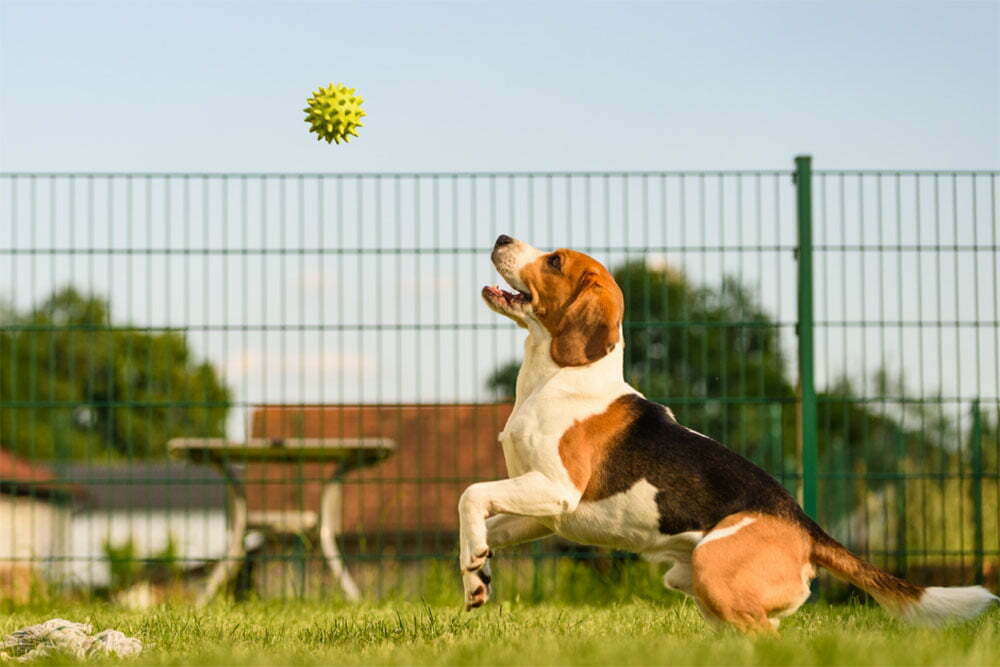If you’re thinking about bringing a dog into your family, make sure you select the proper breed for you and your lifestyle.
Because no two dog breeds are identical, choosing the perfect pup can be a time-consuming and intimidating endeavor. So, we’re here to help!
Have you ever considered a Beagle? They are a fun-loving breed of dog that would fit into practically any family environment. They are cheeky and curious by nature.
There are many things to admire about them, like their bravery and loyalty. However, they require a lot of TLC, just like any other dog.

This guide covers everything you’ll ever need to know about Beagles, including how they behave, how they should be trained, what they’re able to do, their quirks, vulnerabilities, and associated illnesses.
While Beagles can make for a perfect family pet, it’s important to note that, like every breed, they have a few tendencies which can make them less than ideal pets in some situations.
Introducing a new pet into your home is never a decision that should be taken lightly.
Being a responsible pet owner is a huge responsibility, and you’ll need to make sure that you have the means to commit to them for their whole life. So, before you make a decision, let’s dive into the Ultimate Guide to Beagles!
What is a Beagle?
Beagles are scent-hounds that originated in the United Kingdom. First bred to hunt small wildlife, the breed has evolved into a popular companion and detection dog.
While they resembled the larger Fox Hound, hunters valued their smaller stature. The Beagle, unlike other hunting dogs, could be tracked on foot.
The personality of the Beagle is what makes them so appealing to dog owners all over the world. They are sociable, gregarious, gentle, outgoing, and everything a human could want in a canine companion! Beagles may live in apartments due to their small size.
These dogs are adaptable to a wide range of living situations. They can live as happily in the city as they do in the countryside. This breed does not mind moving as long as they are with their family.
Food and love are two of the Beagle’s favorite gifts, but that is certainly true for any dog.
The modern Beagle was developed in the 1830s in Britain. Prior to this, the term “Beagle” was used to denote little dogs that existed millennia before.
They resemble the Harrier and the now-extinct Southern Hound. Modern Beagles are scent hounds bred to hunt hare, rabbits, and other small game.
Smaller Beagles were once found in hunting packs. They were commonly referred to as ‘Pocket Beagles’ and could grow to a maximum height of 9 inches.
They became extinct by 1900, despite being popular with King Henry VII and Queen Elizabeth I. Reverend Phillip Honeywood developed a breeding program in 1830 that is believed to have produced the first Beagle standards.
His hounds were North Country Beagles and Southern Hounds. Thomas Johnson continued the research and created a rough and smooth-coated Beagle.
Some Beagles are still used as working dogs today and can be found in groups throughout the British countryside. Beagle packs are typically made up of ten or more hounds, which explains the breed’s friendliness.
They are also used as narcotic sniffers and other types of detection dogs due to their remarkable scent abilities. The majority of Beagles in modern times are now kept as family pets.
Physical characteristics of the Beagle dog breed
Despite their small size, strength, and athleticism, beagles are nimble and lively.
This is reflected in their body as well as their tiny perceptive faces. The fact that they require little grooming contributes to their popularity in some larger families.

Their short, lustrous coats are waterproof and easy to care for, and they come in all hound-recognized colors, such as tricolor (black, tan, and white); blue, white, and tan; badger pied; hare pied; lemon pied; lemon and white; red and white; tan and white; black and white; all white.
All of the above-mentioned colors, with the exception of all white, can be found as mottle.
Personality traits of the Beagle dog breed
Beagles are intelligent, kind, playful, and calm. They are extremely social and are not known to be aggressive. It’s one of the primary reasons they’re so popular with families. But it can’t be all good!
These dogs are known to enjoy the sound of their own voice and to be headstrong.
Although the Beagle dog is sometimes regarded as “even-tempered,” first-time owners may struggle with their occasionally rebellious demeanor.
Many first-time owners are unaware of the Beagle’s mischievous side, but that doesn’t mean they can’t train this breed.
They are prone to straying, especially if they catch a whiff of something interesting. That means you’ll have to stay alert when exploring and ensure your backyard and other outdoor spaces are properly fenced in.
They are versatile and willing to learn new tricks and skills since they have an instinctive desire to please their owners.
Despite their lively disposition, they just require one to two hours of exercise each day and will be eager to participate in a variety of walks and activities.
Health traits of the Beagle dog breed
Beagles are typically healthy. However, they, like all breeds, are susceptible to some health issues.
Although not all Beagles will get any or all of these ailments, it’s vital to be aware of them if you’re thinking about getting one.
If you’re looking to buy a puppy, be sure to look for a reputable breeder who can show you health certifications for both of your puppy’s parents. Health clearances confirm that a dog has been tested and cleared of a certain condition.
Otitis
Beagles, like other dogs, are prone to skin disorders. This skin condition frequently manifests itself within the ear. You may discover items such as grass seeds or parasites and allergy or infection markings in their ear canal.
Beagles are prone to otitis, which essentially means “infection of the ear canal.” Your dog will itch, causing it to shake or flap its ears and scrape with its paws. If the otitis is caused by an allergy, the dog must be treated for the rest of his life.
Epilepsy
Conditions affecting the brain, spine, and nerves can also affect beagles. Epilepsy is characterized by a series of seizures or fits caused by a brain condition.
This can happen to dogs as young as six months old. Epileptic seizures appear to be painful, although they are not. Epileptic seizures, on the other hand, may need to be controlled with medication in order for your dog to have a happy and normal life.
Thyroid Disease
Thyroid gland diseases are metabolic disorders that might have a negative impact on your dog’s life.
The thyroid glands are located in the neck, and hyperthyroidism is a disorder that occurs when the thyroid glands fail to secrete enough thyroid hormone.
Thyroid dysfunction causes a slow metabolic rate, a slow heart rate, and excessive cold sensitivity. Thyroid hormone replacement therapy must be used to treat hyperthyroidism in your dog for the remainder of his or her life.
Mast Cell Tumors
Tumors, cysts, and growths are common in beagles, including malignant mast cell tumors. Mast cells are skin cells that form as a result of trauma or injury.
It is a single lump within the skin that can cause significant discomfort. These lumps must be surgically removed to guarantee that your dog lives a pain-free and happy life.
Gastrointestinal Disorders
Beagles can suffer from gastrointestinal issues, which are typical in dogs. The GI Tract is a lengthy, twisting organ that extends from the mouth to the anus.
Because of its length, there may be conditions where the bowel becomes obstructed.
A dog may ingest stones, linen, or string, resulting in vomiting and/or diarrhea. Your dog must be treated as soon as possible, and suitable intervention must be provided to ensure a full recovery.
How long can a Beagle live?
A healthy Beagle has a lifespan of 10 to 15 years, which is typical with other breeds of similar size. However, this varies greatly. However, some Beagles have survived for as long as 17 years.
A healthy Beagle lives for roughly 12 years on average. As a result, you may round it up to 13 years, albeit there’s no assurance they’ll live that long.
This indicates a slight increase in Beagle’s lifetime over the last 25 years. The average lifetime of beagle dogs was estimated to be 11 to 12 years in 1994.
How to take care of a Beagle dog
Exercise
Each day, the Beagle dog breed requires up to one hour of exercise. If their activity requirements are not met, the Beagle’s naughty side will emerge!
These dogs, who are superb escape artists, will require a completely fenced garden. Otherwise, their nose will lead them on a wild ride.

Strenuous exercise should be done at least once a day. Beagles’ minds are active and require mental stimulation. Consider including this in their everyday exercise program.
Mental stimulation for a dog can be achieved through interactive games, hide and seek, sniffing and exploring, treat puzzles, and canine sports.
Training
Because of their tenacity, Beagles can be difficult to train. Their fragrance can also be used to distract them, and they will naturally follow their nose. Find out what motivates them.
All that is required is time, consistency, and patience to overcome this. Training sessions should last no more than 10-15 minutes. This easily distracted breed will not be able to focus for long.
A Beagle’s heart and ears are opened by praise and food! If you want them to listen, the best motivator is food! Keep a check on their threat consumption to avoid weight gain.
Housebreaking a Beagle can be difficult, especially if you live in an apartment.
Crate training has proven to be effective for several Beagle owners. Create a toilet routine that is rigorously adhered to. Toilet training will become much easier as your dog learns and falls into this routine.
Grooming
Beagles are low-maintenance when it comes to grooming. A short brush once a week should suffice to keep their coat in good condition. Some owners brush their dogs more frequently than this to avoid shedding, especially in the spring and autumn.
The best grooming equipment for the Beagle’s coat is bristle brushes, slicker brushes, and grooming mitts. Brushing stimulates blood flow, distributes natural oils, and keeps the skin looking young. While their fur sheds, some dead hairs stay in their coats.
Naturally, their coat keeps dirt and dust at bay. Depending on the odor, baths might be given every two to six months. Bathing frequently might dry up the skin, so if they get dirty faster than usual, give them a quick wipe down with a cloth or a short hose down.
The Beagle’s huge ears don’t allow for much ventilation. As a result, they are susceptible to ear infections. Make sure their ears are cleaned once a week. If necessary, nails should be filed every two weeks. Ideally, vets recommend brushing their teeth every day, so aim to do so at least twice a week.
The average price of a Beagle
A Beagle puppy costs between $500 and $2,000 on average. The current median price for all Beagles sold in 2021 is $1,154.
If you want a dog with a strong pedigree (for example, the puppy has show-quality parents), plan to invest $2,000 or more. In some cases, beagles with superior breed lines can cost up to $6,000.
You could always adopt a Beagle or a Beagle mix. Pet adoption typically costs between $350 and $550 and includes registration and vaccines.
You’ll definitely save money, and even better, you’ll provide a beautiful home for a dog who needs one.
Frequently Asked Questions
Are Beagles hypoallergenic?
No. Beagles are not an allergy-friendly breed of dog. Though they are low-maintenance dogs, they shed a substantial amount and carry the protein linked to these allergies.
How bad do Beagles shed?
Beagles don’t shed much. They have short hair, so it is less obvious. However, because this type of dog grows a thicker coat for the winter, they shed quite a bit in the spring. You should be alright as long as you keep up with the hair.
Are Beagles good with children?
Beagles make excellent family dogs. They are compact and simple to administer and maintain. They are also quite lively, which is ideal for keeping up with and playing with small children. They are also very affectionate dogs.
Beagles are naturally tolerant and accepting and will fit in wonderfully with a family if adequately socialized from an early age.
Beagles are a popular family pet due to their size and friendly demeanor, but they can be rather energetic, so always supervise your Beagle while it is around children.
How bad do Beagles shed?
Beagles don’t shed much. They have short hair, so it is less obvious. However, because this type of dog grows a thicker coat for the winter, they shed quite a bit in the spring. You should be alright as long as you keep up with the hair.
How easy are Beagles to train?
Because they were originally bred and employed for hunting, beagles are quite self-sufficient. Because of this, they are highly stubborn and difficult to teach on your own. They are, however, considerably easier to train with obedience classes.
Training a puppy beagle is easier than training an adult one since training becomes more difficult as the dog ages. In conclusion, you must begin training your puppy from the beginning, and it should become a fun game for both of you.
Beagles thrive on mental stimulation, so plan entertaining games like fetch or high-value food incentives during training sessions.
Are Beagles suitable for first-time owners?
Beagles are flexible, versatile canines with loving, inquisitive personalities. They’re even-tempered and enjoy getting involved in whatever the household is up to, making them ideal for first-time owners.
Beagle ownership is a lot of fun since they are gregarious and mischievous, and their instinctive desire to please makes them easy to teach.
You will not have to strain to take your beagle for a walk or exercise, just like you would with any other dog. Beagles are the best and most appropriate choice for first-time owners because they have little or no experience with this wonderful stage of their lives.
